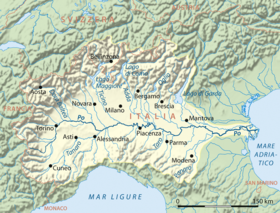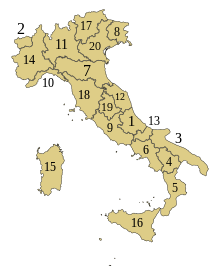
Back Povlakte Afrikaans Poebene ALS وادي بو Arabic Padan ovalığı Azerbaijani Паданская раўніна Byelorussian Паданска низина Bulgarian པོ་ཐང་མ། Tibetan Plana Padana Catalan Pianura Padana CEB Pianura Padana Corsican



The Po Valley, Po Plain, Plain of the Po, or Padan Plain (Italian: Pianura Padana [pjaˈnuːra paˈdaːna] or Val Padana) is a major geographical feature of northern Italy. It extends approximately 650 km (400 mi) in an east-west direction, with an area of 46,000 km2 (18,000 square miles) including its Venetic extension not actually related to the Po basin; it runs from the Western Alps to the Adriatic Sea. The flatlands of Veneto and Friuli are often considered apart since they do not drain into the Po, but they effectively combine into an unbroken plain, making it the largest in Southern Europe. It has a population of 17 million, or a third of Italy's total population.[1]
The plain is the surface of an in-filled system of ancient canyons (the "Apennine Foredeep") extending from the Apennines in the south to the Alps in the north, including the northern Adriatic. In addition to the Po and its affluents, the contemporary surface may be considered to include the Savio, Lamone and Reno to the south, and the Adige, Brenta, Piave and Tagliamento of the Venetian Plain to the north, among the many streams that empty into the north Adriatic from the west and north.
Geo-political definitions of the valley depend on the defining authority. The Po Basin Water Board (Autorità di bacino del fiume Po), authorized in 1989 by Law no. 183/89 to oversee "protection of lands, water rehabilitation, the use and management of hydro resources for the national economic and social development, and protection of related environment" within the Po basin, has authority in several administrative regions of north Italy, including the plain north of the Adriatic and the territory south of the lower Po, as shown in the regional depiction included with this article. The law defines the Po basin as "the territory from which rainwater or snow and glacier melt flows on the surface, gathers in streams of water either directly or via tributaries...".[2] The United Nations Environment Program includes the Alps and Apennines as far as the sources of the tributaries of the Po but excludes Veneto and that portion of Emilia-Romagna south of the lower Po; that is, it includes the region drained by the Po but only the Po and its tributaries.[3]
The altitude of the valley through which the Po flows, exclusive of its tributaries, varies from approximately 4 m (15 feet) below sea level in the Polesine subregion (the delta around Ferrara)[4] to about 2,100 m (6,900 feet) at the river's origin in the southern Piedmontese province of Cuneo, also known as the Provincia granda. The valley is crossed by a number of affluents running down from the Alps in the north and from the Apennines in the south. The Po's major affluents include the Tanaro, Scrivia, Trebbia, Panaro and Secchia in the south, Dora Riparia, Dora Baltea, Sesia, Ticino (draining Lake Maggiore), Lambro, Adda (draining Lake Como), Oglio (draining Lake Iseo) and Mincio (draining Lake Garda and called Sarca in its upper reaches) in the north.
- ^ "FACT SHEET: Po River Basin" (PDF).
- ^ "The Po Basin Water Board, Italy". CABRI-Volga. Retrieved 4 June 2009.
- ^ "Po". United Nations Environment Programme, Division of Early Warning and Assessment (DEWA), Global Resource Information Database (GRID) - Europe. Archived from the original on 1 August 2009. Retrieved 4 June 2009.
- ^ "the Water Board". Consorzio di Bonifica II Circondario - Polesine di San Giorgio. Retrieved 6 June 2009.[permanent dead link]